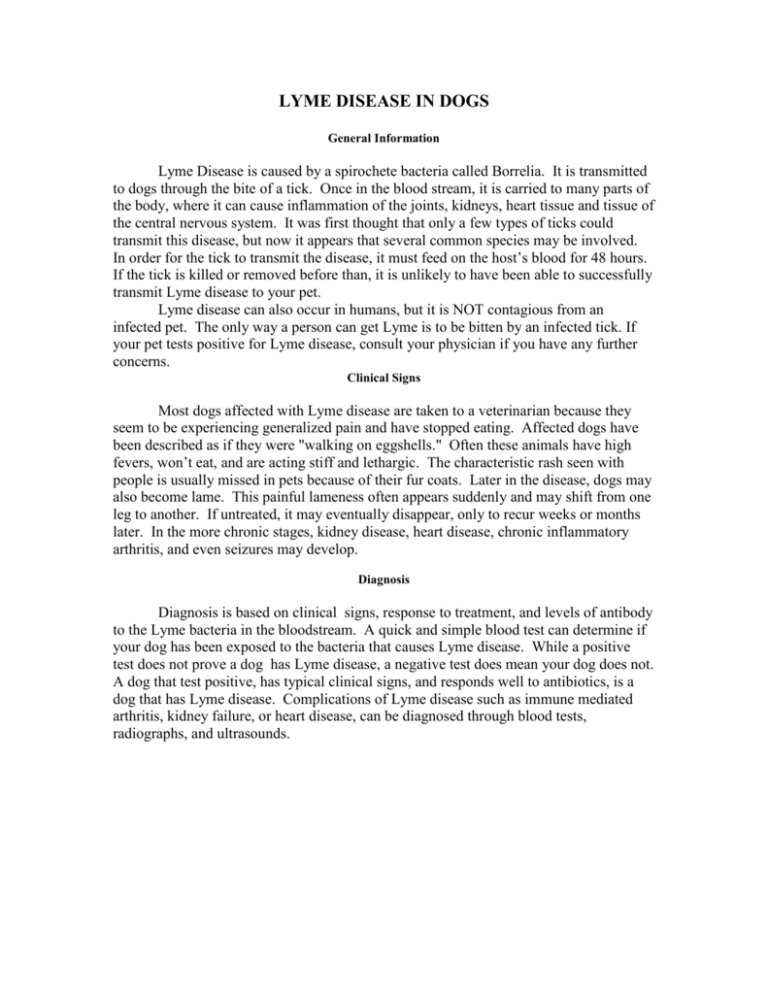LYME DISEASE IN DOGS
advertisement

LYME DISEASE IN DOGS General Information Lyme Disease is caused by a spirochete bacteria called Borrelia. It is transmitted to dogs through the bite of a tick. Once in the blood stream, it is carried to many parts of the body, where it can cause inflammation of the joints, kidneys, heart tissue and tissue of the central nervous system. It was first thought that only a few types of ticks could transmit this disease, but now it appears that several common species may be involved. In order for the tick to transmit the disease, it must feed on the host’s blood for 48 hours. If the tick is killed or removed before than, it is unlikely to have been able to successfully transmit Lyme disease to your pet. Lyme disease can also occur in humans, but it is NOT contagious from an infected pet. The only way a person can get Lyme is to be bitten by an infected tick. If your pet tests positive for Lyme disease, consult your physician if you have any further concerns. Clinical Signs Most dogs affected with Lyme disease are taken to a veterinarian because they seem to be experiencing generalized pain and have stopped eating. Affected dogs have been described as if they were "walking on eggshells." Often these animals have high fevers, won’t eat, and are acting stiff and lethargic. The characteristic rash seen with people is usually missed in pets because of their fur coats. Later in the disease, dogs may also become lame. This painful lameness often appears suddenly and may shift from one leg to another. If untreated, it may eventually disappear, only to recur weeks or months later. In the more chronic stages, kidney disease, heart disease, chronic inflammatory arthritis, and even seizures may develop. Diagnosis Diagnosis is based on clinical signs, response to treatment, and levels of antibody to the Lyme bacteria in the bloodstream. A quick and simple blood test can determine if your dog has been exposed to the bacteria that causes Lyme disease. While a positive test does not prove a dog has Lyme disease, a negative test does mean your dog does not. A dog that test positive, has typical clinical signs, and responds well to antibiotics, is a dog that has Lyme disease. Complications of Lyme disease such as immune mediated arthritis, kidney failure, or heart disease, can be diagnosed through blood tests, radiographs, and ultrasounds. Treatment Because the Lyme spirochete is a bacterium, it can be controlled by antibiotics. However, a lengthy course of treatment is necessary to completely eradicate the organism. The initial antibiotic selected to treat an infected pet may not be effective against the disease, especially if the infection is long-standing. In this situation, a switch to another antibiotic is often effective. Occasionally, the initial infection will recur, or the pet will become reinfected after being bitten by another infected tick. Antibiotics can be prescribed as needed based on your veterinarian’s recommendations. Prevention Lyme prevention is based on protecting your pet from ticks, and by vaccinating high-risk animals against the Lyme bacteria. High-risk dogs are those that are outdoors in the woods or grasses, especially in shore areas, and on the Connecticut line. Any place that has deer is an area likely to have Lyme. To prevent ticks from transmitting the disease, a topical medication like Frontline or Preventic collar can be used. Checking your dog regularly for ticks and removing them as soon as possible is also an excellent means of Lyme prevention. The vaccine available can be given after 12 weeks of age. It is only about 85% effective, and like all vaccines can have potential side effects. Your veterinarian can recommend the best means of prevention based on your pet’s special circumstances. Signs to Watch For Decreased appetite Stiffness Fever, lethargy ADR – “ain’t doing right” in a high risk dog








